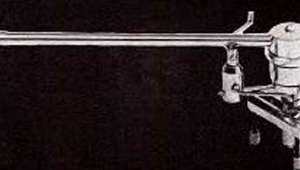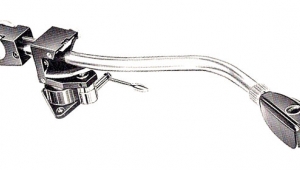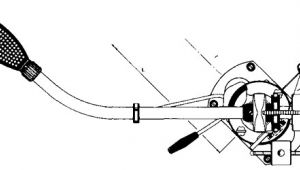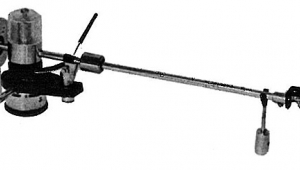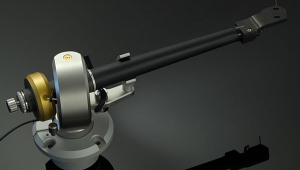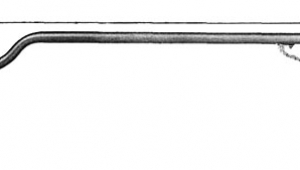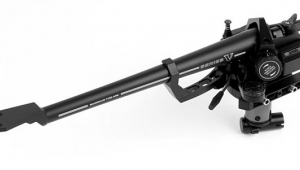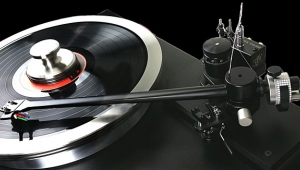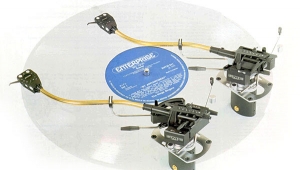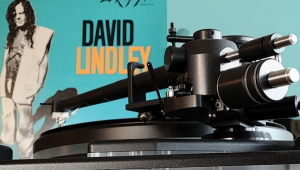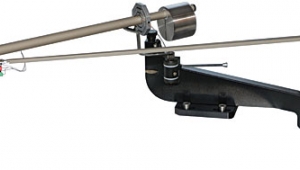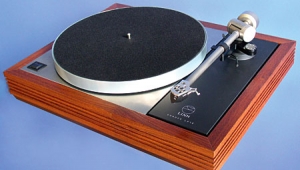| Columns Retired Columns & Blogs |
Naim ARO tonearm & Armageddon turntable power supply Page 2
"Synthesized sinewaves look pretty on a scope and allow you to easily change speed from 33 1/3 to 45rpm, but they just cannot control the motor as well. By using synthesis, you have to utilize oscillators—which then introduce their own filter problems—and we just feel simpler is better."
The conversion from a Basik Linn is quite simple—although best left to a dealer. In my case, it was more complex, as I had the Valhalla power supply already installed, complete with its 50Hz synchronous motor. The first step was to replace the motor with the Basik's 60Hz model. I put the turntable up on a set-up jig and examined its guts, then read the replacement instructions. Whew, this was going to be tough. I know when I'm licked all over—I called Casey McKee, Linn set-up maven supreme, and invited him to fly over from Austin to attend my birthday/housewarming party. "...And, uh, Casey? You might want to bring along your tool kit for a little project I'm working on."
You shouldn't have to trick anyone into setting yours up, but I don't live in a town with a Naim dealer and I assumed that Linn would not be enthusiastic about sending over one of their technicians to set up another company's modification to their product. Another advantage to enticing Casey to Santa Fe is that as an ARO owner, he knew all the set-up tricks for that product as well (footnote 1).
Marcus Sauer's June 1993 review of the ARO (Stereophile Vol.16 No.6, p.161) thoroughly described this wonderful arm. He doesn't leave much to be said on the subject and he and Martin Colloms have campaigned vigorously for its inclusion in Class A in "Recommended Components"—they'll receive no argument from me on that point. However, when the ARO was introduced, unipivot bearing was fairly unusual—had practically been abandoned, you might say. These days, it seems as if the design is flourishing: Graham, Wilson-Benesch, and VPI all offer highly respected variations on the theme.
If you're used to knife-edge bearings, a unipivot will feel fiddly—not to mention rattly—when you cue it up. The first time I used the ARO, I was taken aback. It felt wrong. There are times it still startles me; I've gown so used to the seeming rigidity of other bearing designs that the ARO seems to yaw all around the place in my grip. But in the groove of a record, it tracks as well as any tonearm I've used—seeming unfazed by warps or heavily modulated passages.

One aspect of the ARO's design that still sets it apart from other unipivots is its inversion of the conventional bearing structure: the ARO's armtop carries the spike; the cup in which it rests caps the pillar that supports it. The cup itself is decoupled from the pillar, surrounded with silicone oil to keep it from chattering. As is becoming the norm, the ARO is dynamically balanced—its counterweight sits well below the level of the armtube—which gives it a lower center of gravity, increasing stability at the point of the stylus. Oscillation resolves itself quickly, even without silicone-damping, which can introduces its own problems. "We feel silicone damping to be a Band-Aid approach to a problem that can be more elegantly solved through better engineering," claims West. "The ARO's natural oscillation occurs outside of normal audio frequencies—well below them, obviously. We were inspired, somewhat, by the early Decca tonearm, which employed magnetic damping, but that has its own set of tradeoffs. We feel we eliminated a lot of the clunky bits which kept it from working better."
Not that the ARO is without its own clunky bits. To start with, there's no easy way to adjust overhang. The ARO was designed around Linn's own cartridges (the Troika, actually, although it also works well with the Klyde and Arkiv and that's that. If you wish, you can drill blank armboards based on the cartridge of your choice, but Naim doesn't offer them as options. Fortunately, the Sumiko SHO (or the Transfiguration, for the better-heeled), which I had on hand, closely matches the geometry of the Linn cartridges and offered satisfactory results with the standard armboard.
Another rather funky adjustment: azimuth. A diminutive outrigger weight on the side of the ARO can be adjusted outward to alter azimuth. Obviously, this works only in one direction, pulling outwardly skewed cartridges into alignment toward the center of the disc. What if you need to roll the cartridge body toward the edge of the disc? Nothing. Nada. Zippo. Well there is a way to do it, but surely this couldn't be the officially sanctioned maneuver—could it? What you do is use the rather long fingerlift on the outside of the headshell as a counterbalance: by bending in deeper or shallower curves, you can affect the balance of the stylus in the groove. It works, but feels immoral—in the sense that using a knife as a screwdriver feels wrong. Was this really the adjustment tool they had in mind?
Home is where my 'table is
Properly speaking, I introduced the changes in my system too precipitously—I should have changed only one element and become acquainted with it before passing on to the next change. I wish I'd had that luxury in time and set-up capabilities. But I was flying an old comrade two hours from home as it was, and I couldn't really ask him to do that twice. And, as I've said, I know the Linn sound well in most of its configurations, so I think I can cut myself a little slack here.
- Log in or register to post comments
